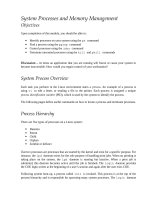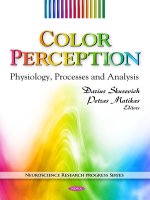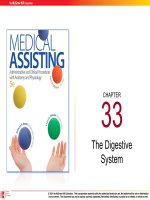Digestive System Processes and Regulation
Bạn đang xem bản rút gọn của tài liệu. Xem và tải ngay bản đầy đủ của tài liệu tại đây (629.53 KB, 9 trang )
Digestive System Processes and Regulation
Digestive System Processes
and Regulation
Bởi:
OpenStaxCollege
The digestive system uses mechanical and chemical activities to break food down into
absorbable substances during its journey through the digestive system. [link] provides
an overview of the basic functions of the digestive organs.
Visit this site for an overview of digestion of food in different regions of the digestive
tract. Note the route of non-fat nutrients from the small intestine to their release as
nutrients to the body.
Functions
of the
Digestive
Organs
Organ
Mouth
Major functions
• Ingests food
• Chews and mixes food
• Begins chemical breakdown
of carbohydrates
• Moves food into the
pharynx
• Begins breakdown of lipids
via lingual lipase
Other functions
• Moistens and dissolves
food, allowing you to taste
it
• Cleans and lubricates the
teeth and oral cavity
• Has some antimicrobial
activity
1/9
Digestive System Processes and Regulation
Functions
of the
Digestive
Organs
Organ
Major functions
Other functions
Pharynx
• Propels food from the oral
cavity to the esophagus
• Lubricates food and
passageways
Esophagus
• Propels food to the stomach
• Lubricates food and
passageways
Stomach
• Mixes and churns food with
gastric juices to form chyme
• Begins chemical breakdown
of proteins
• Releases food into the
duodenum as chyme
• Absorbs some fat-soluble
substances (for example,
alcohol, aspirin)
• Possesses antimicrobial
functions
• Stimulates proteindigesting enzymes
• Secretes intrinsic factor
required for vitamin B12
absorption in small
intestine
Small
intestine
• Mixes chyme with digestive
juices
• Propels food at a rate slow
enough for digestion and
absorption
• Absorbs breakdown
products of carbohydrates,
proteins, lipids, and nucleic
acids, along with vitamins,
minerals, and water
• Performs physical digestion
via segmentation
• Provides optimal medium
for enzymatic activity
Accessory
organs
• Liver: produces bile salts,
which emulsify lipids,
aiding their digestion and
absorption
• Gallbladder: stores,
concentrates, and releases
bile
• Bicarbonate-rich pancreatic
juices help neutralize
acidic chyme and provide
optimal environment for
enzymatic activity
2/9
Digestive System Processes and Regulation
Functions
of the
Digestive
Organs
Organ
Major functions
Other functions
• Pancreas: produces
digestive enzymes and
bicarbonate
Large
intestine
• Further breaks down food
residues
• Absorbs most residual
water, electrolytes, and
vitamins produced by
enteric bacteria
• Propels feces toward rectum
• Eliminates feces
• Food residue is
concentrated and
temporarily stored prior to
defecation
• Mucus eases passage of
feces through colon
Digestive Processes
The processes of digestion include six activities: ingestion, propulsion, mechanical or
physical digestion, chemical digestion, absorption, and defecation.
The first of these processes, ingestion, refers to the entry of food into the alimentary
canal through the mouth. There, the food is chewed and mixed with saliva, which
contains enzymes that begin breaking down the carbohydrates in the food plus some
lipid digestion via lingual lipase. Chewing increases the surface area of the food and
allows an appropriately sized bolus to be produced.
Food leaves the mouth when the tongue and pharyngeal muscles propel it into the
esophagus. This act of swallowing, the last voluntary act until defecation, is an example
of propulsion, which refers to the movement of food through the digestive tract. It
includes both the voluntary process of swallowing and the involuntary process of
peristalsis. Peristalsis consists of sequential, alternating waves of contraction and
relaxation of alimentary wall smooth muscles, which act to propel food along ([link]).
These waves also play a role in mixing food with digestive juices. Peristalsis is so
powerful that foods and liquids you swallow enter your stomach even if you are standing
on your head.
3/9
Digestive System Processes and Regulation
Peristalsis
Peristalsis moves food through the digestive tract with alternating waves of muscle contraction
and relaxation.
Digestion includes both mechanical and chemical processes. Mechanical digestion is a
purely physical process that does not change the chemical nature of the food. Instead,
it makes the food smaller to increase both surface area and mobility. It includes
mastication, or chewing, as well as tongue movements that help break food into smaller
bits and mix food with saliva. Although there may be a tendency to think that
mechanical digestion is limited to the first steps of the digestive process, it occurs after
the food leaves the mouth, as well. The mechanical churning of food in the stomach
serves to further break it apart and expose more of its surface area to digestive juices,
creating an acidic “soup” called chyme. Segmentation, which occurs mainly in the small
intestine, consists of localized contractions of circular muscle of the muscularis layer of
the alimentary canal. These contractions isolate small sections of the intestine, moving
their contents back and forth while continuously subdividing, breaking up, and mixing
the contents. By moving food back and forth in the intestinal lumen, segmentation mixes
food with digestive juices and facilitates absorption.
In chemical digestion, starting in the mouth, digestive secretions break down complex
food molecules into their chemical building blocks (for example, proteins into separate
amino acids). These secretions vary in composition, but typically contain water, various
enzymes, acids, and salts. The process is completed in the small intestine.
Food that has been broken down is of no value to the body unless it enters the
bloodstream and its nutrients are put to work. This occurs through the process of
absorption, which takes place primarily within the small intestine. There, most nutrients
are absorbed from the lumen of the alimentary canal into the bloodstream through the
epithelial cells that make up the mucosa. Lipids are absorbed into lacteals and are
transported via the lymphatic vessels to the bloodstream (the subclavian veins near the
heart). The details of these processes will be discussed later.
4/9
Digestive System Processes and Regulation
In defecation, the final step in digestion, undigested materials are removed from the
body as feces.
Aging and the…
Digestive System: From Appetite Suppression to Constipation Age-related changes
in the digestive system begin in the mouth and can affect virtually every aspect of
the digestive system. Taste buds become less sensitive, so food isn’t as appetizing as
it once was. A slice of pizza is a challenge, not a treat, when you have lost teeth,
your gums are diseased, and your salivary glands aren’t producing enough saliva.
Swallowing can be difficult, and ingested food moves slowly through the alimentary
canal because of reduced strength and tone of muscular tissue. Neurosensory feedback
is also dampened, slowing the transmission of messages that stimulate the release of
enzymes and hormones.
Pathologies that affect the digestive organs—such as hiatal hernia, gastritis, and peptic
ulcer disease—can occur at greater frequencies as you age. Problems in the small
intestine may include duodenal ulcers, maldigestion, and malabsorption. Problems in the
large intestine include hemorrhoids, diverticular disease, and constipation. Conditions
that affect the function of accessory organs—and their abilities to deliver pancreatic
enzymes and bile to the small intestine—include jaundice, acute pancreatitis, cirrhosis,
and gallstones.
In some cases, a single organ is in charge of a digestive process. For example, ingestion
occurs only in the mouth and defecation only in the anus. However, most digestive
processes involve the interaction of several organs and occur gradually as food moves
through the alimentary canal ([link]).
5/9
Digestive System Processes and Regulation
Digestive Processes
The digestive processes are ingestion, propulsion, mechanical digestion, chemical digestion,
absorption, and defecation.
Some chemical digestion occurs in the mouth. Some absorption can occur in the mouth
and stomach, for example, alcohol and aspirin.
Regulatory Mechanisms
Neural and endocrine regulatory mechanisms work to maintain the optimal conditions
in the lumen needed for digestion and absorption. These regulatory mechanisms, which
stimulate digestive activity through mechanical and chemical activity, are controlled
both extrinsically and intrinsically.
Neural Controls
The walls of the alimentary canal contain a variety of sensors that help regulate digestive
functions. These include mechanoreceptors, chemoreceptors, and osmoreceptors, which
are capable of detecting mechanical, chemical, and osmotic stimuli, respectively. For
example, these receptors can sense when the presence of food has caused the stomach
to expand, whether food particles have been sufficiently broken down, how much liquid
is present, and the type of nutrients in the food (lipids, carbohydrates, and/or proteins).
6/9
Digestive System Processes and Regulation
Stimulation of these receptors provokes an appropriate reflex that furthers the process
of digestion. This may entail sending a message that activates the glands that secrete
digestive juices into the lumen, or it may mean the stimulation of muscles within the
alimentary canal, thereby activating peristalsis and segmentation that move food along
the intestinal tract.
The walls of the entire alimentary canal are embedded with nerve plexuses that interact
with the central nervous system and other nerve plexuses—either within the same
digestive organ or in different ones. These interactions prompt several types of reflexes.
Extrinsic nerve plexuses orchestrate long reflexes, which involve the central and
autonomic nervous systems and work in response to stimuli from outside the digestive
system. Short reflexes, on the other hand, are orchestrated by intrinsic nerve plexuses
within the alimentary canal wall. These two plexuses and their connections were
introduced earlier as the enteric nervous system. Short reflexes regulate activities in one
area of the digestive tract and may coordinate local peristaltic movements and stimulate
digestive secretions. For example, the sight, smell, and taste of food initiate long
reflexes that begin with a sensory neuron delivering a signal to the medulla oblongata.
The response to the signal is to stimulate cells in the stomach to begin secreting digestive
juices in preparation for incoming food. In contrast, food that distends the stomach
initiates short reflexes that cause cells in the stomach wall to increase their secretion of
digestive juices.
Hormonal Controls
A variety of hormones are involved in the digestive process. The main digestive
hormone of the stomach is gastrin, which is secreted in response to the presence of
food. Gastrin stimulates the secretion of gastric acid by the parietal cells of the stomach
mucosa. Other GI hormones are produced and act upon the gut and its accessory organs.
Hormones produced by the duodenum include secretin, which stimulates a watery
secretion of bicarbonate by the pancreas; cholecystokinin (CCK), which stimulates the
secretion of pancreatic enzymes and bile from the liver and release of bile from the
gallbladder; and gastric inhibitory peptide, which inhibits gastric secretion and slows
gastric emptying and motility. These GI hormones are secreted by specialized epithelial
cells, called endocrinocytes, located in the mucosal epithelium of the stomach and small
intestine. These hormones then enter the bloodstream, through which they can reach
their target organs.
Chapter Review
The digestive system ingests and digests food, absorbs released nutrients, and excretes
food components that are indigestible. The six activities involved in this process are
ingestion, motility, mechanical digestion, chemical digestion, absorption, and
defecation. These processes are regulated by neural and hormonal mechanisms.
7/9
Digestive System Processes and Regulation
Interactive Link Questions
Visit this site for an overview of digestion of food in different regions of the digestive
tract. Note the route of non-fat nutrients from the small intestine to their release as
nutrients to the body.
Answers may vary.
Multiple Choice
Which of these processes occurs in the mouth?
1.
2.
3.
4.
ingestion
mechanical digestion
chemical digestion
all of the above
D
Which of these processes occurs throughout most of the alimentary canal?
1.
2.
3.
4.
ingestion
propulsion
segmentation
absorption
B
Which of the following stimuli activates sensors in the walls of digestive organs?
1.
2.
3.
4.
breakdown products of digestion
distension
pH of chyme
all of the above
D
Which of these statements about reflexes in the GI tract is false?
1.
2.
3.
4.
Short reflexes are provoked by nerves near the GI tract.
Short reflexes are mediated by the enteric nervous system.
Food that distends the stomach initiates long reflexes.
Long reflexes can be provoked by stimuli originating outside the GI tract.
8/9
Digestive System Processes and Regulation
A
Critical Thinking Questions
Offer a theory to explain why segmentation occurs and peristalsis slows in the small
intestine.
The majority of digestion and absorption occurs in the small intestine. By slowing the
transit of chyme, segmentation and a reduced rate of peristalsis allow time for these
processes to occur.
It has been several hours since you last ate. Walking past a bakery, you catch a whiff of
freshly baked bread. What type of reflex is triggered, and what is the result?
The smell of food initiates long reflexes, which result in the secretion of digestive juices.
9/9









